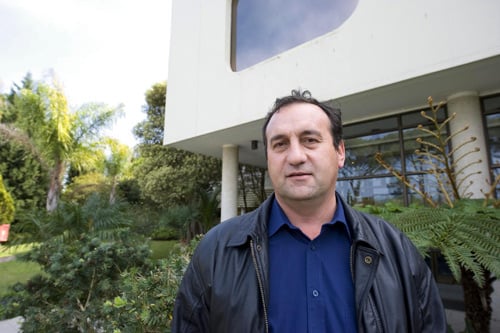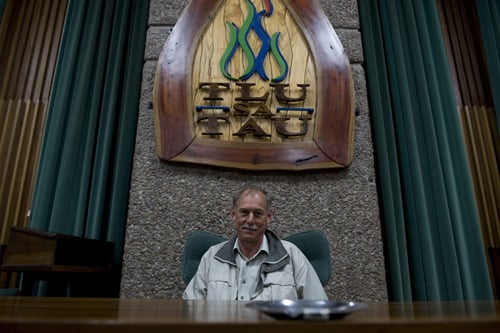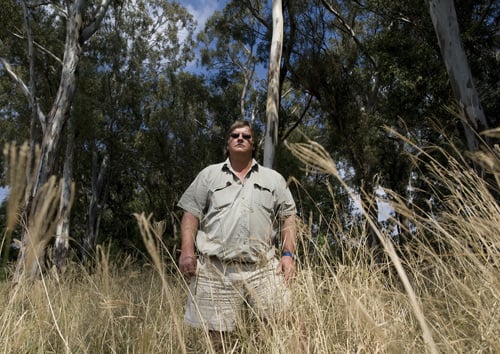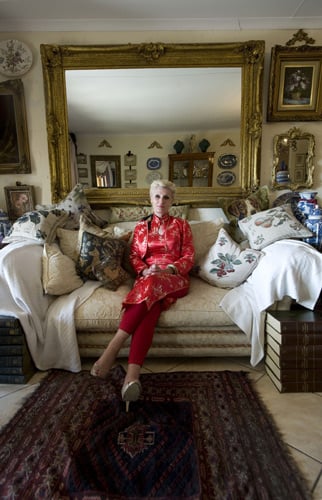The inconvenient truths about our polluted water supplies aren’t going unchallenged — at least not by these activists. Sean Christie meets the environmentalists on the front lines of the battle over our eroding water systems
The principled insider
Carin Bosman worked for the Department of Water Affairs both before and after 1994 and has the unassailable distinction of having pissed off people on both sides of that political divide.
As an independent consultant these days, her technical knowledge, coupled with her managerial ability and first-hand experience of “the politics of pollution”, has seen her drawn into some of the biggest environmental scraps of the day, such as the ongoing Vele Colliery debacle in Limpopo, where she hopes that her evaluation of Coal of Africa’s environmental management programme report will contribute to the closure and rehabilitation of the mine.

Carin Bosman: ‘The only change sine 1994 in regard to the politics of pollution has been skin colour’ (Paul Botes, M&G)
“The only change since 1994 in regard to the politics of pollution has been skin colour,” says Bosman. “You may recall we had a racing car in Formula One. That was the politics of pollution at work. Sasol knew that the minister at the time, Gert Kotze, was a big racing car fan and when its environmental impact came under scrutiny my colleagues were told to lay off and the next thing, South Africa had this car.” (Sasol was the title sponsor of the Jordan Grand Prix team during the 1992, 1993 and 1994 Formula One World Championship seasons.)
In 2005, as director of water resource protection and waste management at the department of water affairs, Bosman was instrumental in getting a number of big-name gold mines in the vicinity of Klerksdorp to share the cost of groundwater pumping operations at mines that had been liquidated by DRD Gold to keep the shafts from flooding and creating a massive acid mine drainage problem in the process.
“It was the first time the strength of section 19 of the National Water Act was ever tested and it passed the tests,” says Bosman, adding that South Africa has excellent liability laws. Her wrangles with mining managing directors were nothing compared with the battles fought in the corridors of the department itself, however. “I was under severe pressure to let these guys off the hook — it was very hard,” says Bosman, who was shown the door after butting heads with the director general.
“I used to work for SA.gov but I now work for SA.org through my company, Sustainable Solutions. Sometimes it pays, usually it doesn’t. My focus is still on communities, and I don’t beat around the bush. We need as many people as possible to keep pointing out that the politics of pollution are actually killing us.”
The impatient scientist
Dr Paul Oberholster wants a chair in water quality and food security. It seems a reasonable thing to want. Nobody would deny that South Africa has water quality issues and that they threaten food security. Oberholster is a senior limnologist at the Council for Scientific and Industrial Research (CSIR), one of only a handful of water quality specialists left in the country. If the likes of him aren’t going to direct research at these critical issues, then who?
The politics of pollution, however, do not answer to reason, neither do the politics of research, for that matter.

Dr Paul Oberholster: ‘As scientists, we come to a point where we finish the research and nothing is done about it. (David Harrison, M&G)
Water research in the country is fragmented and often embargoed, as are the mines and industry sponsor reports which never see the light of day.
“As scientists we come to a point where we finish the research and nothing happens afterwards. It’s not the way forward,” says Oberholster, who spends much of his time on the banks of the Olifants River and Loskop Dam, where he is leading a major water quality study. That study, too, is confidential.
So, Oberholster has decided to become more than a scientist, he’s pushing for a CSIR chair that will direct practical research at the gaps in our knowledge about water quality and what it’s doing to our food.
He insists there’s no material motive in all of this, or he would have embraced private sector consultancy work long ago. What motivates him, he says, is the plight of the poorer communities along South Africa’s poisoned rivers.
“For 19 years I was a teacher, so the community is part of my life. Also, I became sick from working with polluted water when I was still studying. I’ve experienced first hand the toll it can have. That’s what keeps me going. We need to do more than just speak about the problem.”
The unionist
In May this year Louis Meintjies, on behalf of the Transvaal Agricultural Union (TAU), walked into Pretoria’s Brooklyn police station and laid criminal charges against the ministers of water, minerals, and agriculture for neglecting to do anything about the increasingly degenerate state of South Africa’s water systems.
By September the country had seen a flurry of water-conscious interventions from government.

Louis Meintjies: ‘Do we know how much land and water we need in order to be self-sufficient in food?’ (Paul Botes)
And while it would be misleading to credit Meintjies with the government’s newfound environmental concern, few would argue that of all the water activists who ratcheted up the pressure in 2010, he has been the most strident.
“We need, all of us, to stop having conferences or workshops on water quality. Since the African Water Conference last year there have been 18 nearly identical conferences, where the same people present again and again.
“We need to get beyond stating the problem and focus on finding solutions,” he says.
Meintjies’s approach is given particular coherence and focus by the fact that he is a farmer in a water-strapped part of the country, who happens to represent farmers with myriad water concerns.
It is because of their concerns that he established the National Water Forum, and as chairperson of this vehicle that he suggested to the CSIR’s Paul Oberholster that a chair in water quality and food security was required to direct research on the effects of polluted water on agricultural production.
His particular approach is perhaps best encapsulated by the action of a single minute during the AgriSA water conference in early August. After a day of speeches and presentations Meintjies was the first to put his hand in the air.
“Do we know how much land and water we need in order to be self-sufficient in food?” he asked.
The question caused some uncomfortable shifting in seats. “Let me put it another way,” Meintjies continued: “Do we intend importing our food in future? Do we want to be dependent on our neighbours for food? It must be so, because that can be the only outcome if we continue to do to our rivers and dams what we are doing now.”
The panellists dodged the question that day, but Meintjies will have his hand up at the next conference, of that you can be sure. And he will keep on asking until someone gives him a straight answer, because, being a farmer, he understands that problems don’t go away until they are solved.
The stubborn farmer
Dr Koos Pretorius doesn’t have a problem with mining, exactly, it’s simply that he’s done the maths on coal mining in his own neck of the woods and discovered that it isn’t sustainable.
“The pollution remediation costs of coal mining endure for hundreds of years. Any economist will immediately point out that this is unsustainable and yet everybody still thinks coal mining is such a profitable business. This is because miners simply don’t pay for the bulk of their costs, they are all externalised to the taxpayer, the environment and the communities that rely on that environment.”

Dr Koos Pretorius: ‘The pollution remediation costs of coal mining endure for hundreds of years.'(Paul Botes)
This inconvenient truth, and the fact that there are plans afoot for 4 500 hectares’ worth of open-cast mines near Pretorius’s beloved Belfast, galvanised the veterinarian turned cherry farmer to establish the Escarpment Environmental Protection Group, which promptly began laying criminal charges against some rather large mining houses.
With other NGOs and private appellants, Pretorius has dragged several companies before the water tribunal for mining without a water licence. He’s the big thorn in the side of big coal.
It makes Pretorius particularly mad that deals for coal-bearing land are struck between miners and farmers over the heads of farm workers, who are classically left to make do in reconstruction and development squats in the nearest township or in houses built by the mines in the middle of nowhere at extremely low cost.
To counter this, Pretorius conducts workshops on workers’ rights, which have brought him into conflict with miners and farmers who fail to acknowledge that his campaign to stall unregulated coal mining might just save their livelihood.
Noble as all of this sounds, noblesse oblige is refreshingly absent from Pretorius’s advocacy.
“When this is finished, I’m done. I’m not even on the school council or anything like that. I’d like nothing better right now than to just be sitting on my verandah with a beer in my hand.”
Our lady of the mines
In 1996 South African mines approached the government with a major concern. Acid mine drainage (AMD) was due to begin decanting from the western basin of the Witwatersrand in 2002 and they suggested it would be a good idea to come up with a management plan to mitigate its impact. In 1999 the Strategic Waste Water Management Plan (Swamp) was presented to Parliament but the portfolio committee passed it over, a decision that did not stop the 2002 decant from happening on time, with devastating human and environmental consequences. Still the government did nothing.
If ever there was a need for determined individuals and NGOs to step in and hold both the government and the mines to account in terms of the many laws their fence-sitting was in conflict with (the National Water Act, the National Environmental Management Act, the Mineral and Petroleum Resources Development Act, the National Nuclear Regulator Act and the Constitution), this was it, but that was exactly the problem: any activism would be directed at the most powerful public-private alliance the country has ever seen.
Undeterred, an activist called Mariette Liefferink entered the fray. She was barely noticed at first, but her name gradually became synonymous with AMD and her voice grew louder until it became impossible to ignore. On August 19 Cabinet handed the minister of water affairs a mandate to assemble a team to look into ways of mitigating the country’s AMD problems — a decision which appears to represent a major shift in the government’s approach to AMD. And few would deny that Liefferink played a major role in changing the minds that mattered.

Mariette Liefferink: ‘I come from a long line of jurists … and I think that a sense of justice was instilled in me at a vey young age’. (Paul Botes)
Liefferink lives in a smallish house in Bryanston, in one of the many housing complexes that have proliferated there.
It’s a faux-Tuscan complex, tan and bland, and this makes it all the more interesting to be greeted at the filigree gate by a tall, slender woman in a red Chinese dress, modest in cut if not in colour. She wears band-like black sunglasses to protect her blue eyes from the Highveld UV rays and waves me into a living room dense with porcelain urns, china plates, embossed cushions and elaborate gold-leaf mirrors.
“I was married to a wealthy man,” she says. “We had three houses, so you can imagine, a lot of stuff now has to fit inside a much smaller space.”
It’s immediately clear that the regular comparisons with her American activist counterpart Erin Brockovich are imprecise — where Brockovich in her heyday was all décolletage and west-coast directness, Liefferink is as decorous and prim as only an urbanised plaasmeisie from a notable Eastern Cape legal family could be. She found the movie discouraging, incidentally.
“In the case of her fight the issues were not major ones. Here in South Africa, we are dealing with multinational gold mining companies that created the largest gold-mining basin in the world, with hundred-year impacts, and yet it seems this has not raised the same awareness as her campaign,” she says.
Liefferink traces her activism back to 1995, the year that Royal Dutch Shell began buying up properties in her neck of Bryanston with a view to developing a pilot suburban Ultra City.
“Basically, I was actuated by the Nimby principle — not in my back yard. It was pure narrow self-interest,” she says.
After seven years of unsuccessful attempts to get around Liefferink, Shell backed away from a concept in which they had invested significant funds.
“That gave me a sense of grandiosity. I suddenly felt that one woman could really make a difference. From that followed other, smaller campaigns and then 53 landowners in the vicinity of West Driefontein gold mine approached me, alleging that they could no longer irrigate after the miner had dewatered the aquifer. I accepted their request for help because I was shocked at the injustice of the gold mining — how the richest gold mine in history was externalising all its impacts upon a poor community.”
Liefferink went on to grapple with the heavyweights of the Witwatersrand — Goldfields, AngloGold Ashanti, First Uranium, Harmony Gold — moving from the “narrow self-interest” of the Nimby principle to a life of helping others for no financial reward.
“I come from a very long line of jurists,” Liefferink says when I ask her where the altruism comes from. “I was raised on the court benches and I think that sense of justice was instilled in me at a very young age.”
She took a law diploma but never practised. Instead she became an ordained minister and stuck to her calling for 30 years.
“The denomination was one that required me to walk from house to house every day. We worked out that it would take 1 000 hours to make one disciple and I think that established a very good background for me because now I also go persistently from house to house, or from hut to hut, but instead of preaching religion my advocacy is now environmental matters,” she says.
And so Liefferink has gone about her work, aggregating embargoed research papers and studying environmental management plans (EMPs) and then going out to the goldfields with great regularity to hear for herself how the miners’ deviations from their own EMPs are affecting communities. Wherever she has discovered transgressions she has reported them to the relevant organs of state and simultaneously whistle-blown to the media, despite the fact that she is largely funded by the mines themselves (an uncomfortable strategic frisson that a recent University of Pretoria booklet on AMD identified as a weakness of her activism).
It has never been easy. The university booklet suggests Liefferink “speaks from the point of view of ‘we’ because she needs the legitimacy of public support for her efforts and for her activities and organisation to be noticed and respected. The reality for her is, however, that her activist pursuits are very lonely and that it is she alone who maintains the momentum of raising awareness and exerting pressure on government with regard to AMD and other problems caused by mining companies.”
I ask about loneliness and Liefferink says she has, indeed, been isolated for much of the time. “I have absolutely no social life, but I don’t miss it because I’m constantly interacting with many stimulating people in government and industry,” she says.
She thinks about her answer for a bit and then the instinct for absolute truth and accountability that has carried her activism so far kicks in and she decides to add to it. “Some might call what I do an obsession — it is an obsession — but for me to have a purpose for living, to have a meaning for life, not simply to have a hopeless and helpless and hapless existence, that is also the reason I continue. I hope, without impeachment or forfeiture of modesty, I can say: I think I have made a little difference.”